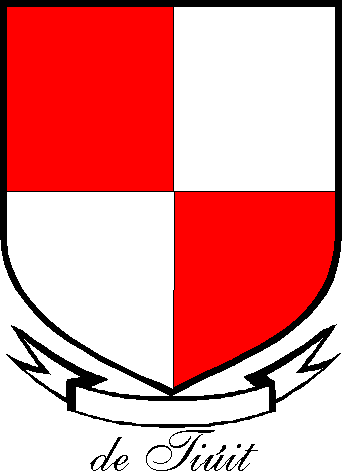
Risteárd de Tiúit
Encyclopedia

Richard de Clare, 2nd Earl of Pembroke
Richard de Clare, 2nd Earl of Pembroke , Lord of Leinster, Justiciar of Ireland . Like his father, he was also commonly known as Strongbow...
's Irish invasion force, and Lord Chief Justice of Ireland. His part in the original invasion is acknowledged in The Song of Dermot and the Earl, which recorded his grant of land in the western part of Meath (present-day Westmeath and Longford
Longford
Longford is the county town of County Longford in Ireland. It has a population of 7,622 according to the 2006 census. Approximately one third of the county's population resides in the town. Longford town is also the biggest town in the county...
) under the authority of Hugh de Lacy in Trim
Trim, County Meath
Trim is the traditional county town of County Meath in Ireland, although the county town is now Navan. The town was recorded in the 2006 census to have a population of 6,870....
.
Introduction
He built one of the largest Motte and Bailey settlements in Ireland in GranardGranard
Granard is a town in the north of County Longford, Ireland and has a traceable history going back to 236 A.D.. It is situated just south of the boundary between the watersheds of the Shannon and the Erne, at the point where the N55 national secondary road and the R194 regional road...
in 1199. His death, while Lord Chief Justice of Ireland, is recorded in Athlone by the Annals of the Four Masters under the year 1210 and his remains lie today in Abbeylara
Abbeylara
Abbeylara is a village in the easternmost portion of County Longford, Ireland, located about three kilometers east of Granard on the R369 regional road. Its name is derived from a monastery, the great Abbey of Lerha, founded in 1205 by Hiberno-Norman magnate, Risteárd de Tiúit, for Cistercian monks...
's Cistercian abbey.
Descendants
Risteárd de Tiúit had two sons who survived him, Risteárd 'Dubh' de Tiúit, the eldest son and heir to the title and lands, and Muiris. Lodge's Peerage says that it was this Risteárd, Risteárd Dubh, who established the monastery at Granard about 1210 and at this time Risteárd Dubh already held the manors of Kilalton and Demar, and was enfeoffedEnfeoffment
Under the European feudal system, enfeoffment was the deed by which a person was given land in exchange for a pledge of service. This mechanism was later used to avoid restrictions on the passage of title in land by a system in which a landowner would give land to one person for the use of another...
in that of Kilstir in Meath. Muiris became Lord of Jordanstown and had four sons who survived him, Tomás (Thomas), Piaras, Matthew and Ruairí (Roger).
De Tiúit is also the ancestor of those who bear the de Tiúit/ Tuite surname. He is variously recorded as Tiúit, Diúit and Tuit. Numerous placenames in Meath (Tuiterath), Cavan (Droim Thiúit/ Drumyouth), Westmeath (Tuitestown in Fore; Tuitestown in Moyashel and Magheradernon, and Ballysallagh Tuite), Kilkenny (Baile an Tiúigh Thoir/ Tuitestown and Baile an Tiúigh Beag/ Tuitestown Little) and elsewhere are named after him and his descendants. The surname is from the Eure region of Normandy where the root, Tuit, indicates a clearing in a wooded area and may be the local development of the Scandinavian placename, Thveit, brought by the Normans
Normans
The Normans were the people who gave their name to Normandy, a region in northern France. They were descended from Norse Viking conquerors of the territory and the native population of Frankish and Gallo-Roman stock...
when they settled in Normandy.
See also
- Hiberno-NormanHiberno-NormanThe Hiberno-Normans are those Norman lords who settled in Ireland who admitted little if any real fealty to the Anglo-Norman settlers in England, and who soon began to interact and intermarry with the Gaelic nobility of Ireland. The term embraces both their origins as a distinct community with...
- Norman IrelandNorman IrelandThe History of Ireland 1169–1536 covers the period from the arrival of the Cambro-Normans to the reign of Henry VIII of England, who made himself King of Ireland. After the Norman invasion of 1171, Ireland was under an alternating level of control from Norman lords and the King of England...
- Annals of the Four Masters
- Cambro-Norman Surnames of Ireland
- Chief Justice of IrelandLord Chief Justice of Irelandthumb|200px|The Four CourtsThe headquarters of the Irish judicial system since 1804. The Court of King's Bench was one of the original four courts that sat there....
- Tuite Surname Distribution Today

